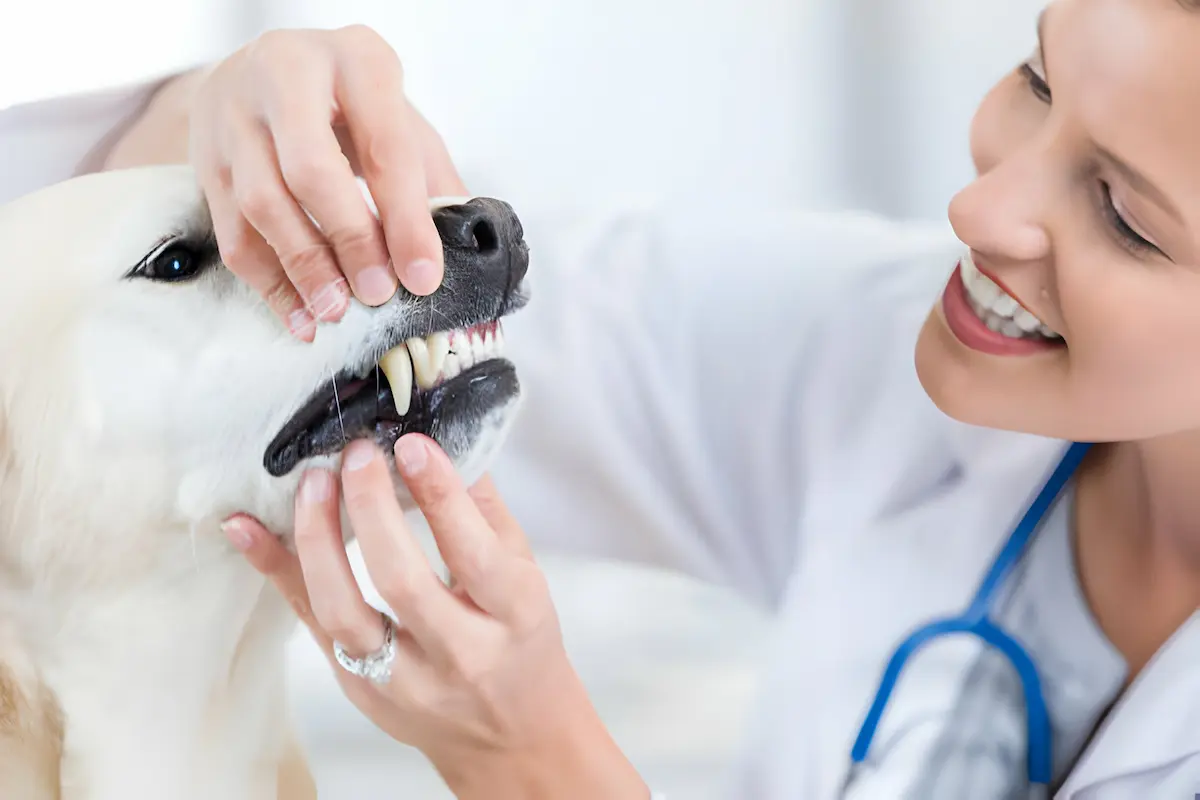Dental hygiene is crucial for the overall health and well-being of our canine companions. Just like humans, dogs require regular dental care to prevent oral issues such as plaque buildup, tartar accumulation, gum disease, and tooth decay. While brushing and dental treats play a significant role in maintaining oral health, sometimes deeper cleaning is necessary to tackle stubborn plaque and tartar. This is where ultrasonic teeth cleaning comes into play.
How Does Ultrasonic Teeth Cleaning Work?
Ultrasonic teeth cleaning is a non-invasive procedure performed by veterinary dentists to remove plaque and tartar from a dog’s teeth using ultrasonic scalers. These scalers emit high-frequency vibrations that break down plaque and tartar without causing harm to the tooth enamel or soft tissues. The procedure is gentle, efficient, and pain-free, making it an ideal choice for dogs who may be resistant to traditional teeth cleaning methods.
Advantages of Ultrasonic Teeth Cleaning for Dogs
One of the key advantages of ultrasonic teeth cleaning is its effectiveness in removing plaque and tartar from hard-to-reach areas of the mouth. Unlike manual scaling, which can be time-consuming and uncomfortable for the dog, ultrasonic cleaning offers a quick and thorough solution. Additionally, regular ultrasonic cleanings can reduce the risk of dental diseases such as gingivitis and periodontitis, ultimately improving the dog’s overall oral health and quality of life.
Preparing Your Dog for Ultrasonic Teeth Cleaning
Preparing your dog for an ultrasonic teeth cleaning involves several steps to ensure a smooth and stress-free experience. First, it’s essential to schedule a pre-checkup with your veterinarian to assess your dog’s dental health and determine if they are a suitable candidate for the procedure. This also allows the vet to address any underlying issues that may need to be addressed before the cleaning.
During the pre-checkup, your vet may recommend a dental examination and possibly blood work to ensure your dog is healthy enough to undergo anesthesia, which is often used during ultrasonic teeth cleaning. It’s also important to follow any preoperative instructions provided by your vet, such as fasting your dog before the procedure to reduce the risk of aspiration.
On the day of the cleaning, make sure your dog is calm and relaxed by avoiding stressful situations and providing plenty of positive reinforcement. Bringing along their favorite toy or blanket can also help them feel more comfortable in the unfamiliar environment of the veterinary clinic.
The Procedure: What to Expect
The ultrasonic teeth cleaning procedure typically begins with a thorough examination of the dog’s mouth to identify any areas of concern. Once the vet has assessed the dental health of the dog, they will administer anesthesia to ensure the dog remains still and comfortable throughout the cleaning process.
Next, the vet will use an ultrasonic scaler to carefully remove plaque and tartar from the dog’s teeth, paying special attention to areas where buildup is most significant. The scaler emits high-frequency vibrations that break down the hardened deposits, making them easier to remove without causing damage to the tooth enamel.
After the cleaning is complete, the vet may polish the dog’s teeth to smooth out any rough surfaces and prevent plaque from re-accumulating. They may also apply a fluoride treatment to strengthen the teeth and further reduce the risk of dental issues.
Common Misconceptions About Ultrasonic Teeth Cleaning
Despite its effectiveness and safety, there are some common misconceptions surrounding ultrasonic teeth cleaning for dogs. One of the most prevalent myths is that anesthesia-free dental cleanings are a safer alternative to traditional cleanings performed under anesthesia. However, anesthesia-free cleanings often only address the visible surfaces of the teeth and do not provide a thorough cleaning below the gum line where dental disease often originates.
Another misconception is that ultrasonic teeth cleaning is painful or harmful to dogs. In reality, the procedure is gentle and pain-free, thanks to the use of anesthesia and specialized equipment designed specifically for veterinary dental care. Additionally, the benefits of ultrasonic cleaning far outweigh any potential risks, especially when performed by a qualified veterinary dentist.
Choosing the Right Professional for the Job
When it comes to your dog’s dental health, it’s essential to choose a qualified and experienced professional for the job. Look for a veterinary dentist who is board-certified by the American Veterinary Dental College (AVDC) and has extensive training and expertise in dental procedures for dogs.
Before scheduling an appointment, don’t hesitate to ask questions about the vet’s qualifications, experience, and the specific techniques they use for ultrasonic teeth cleaning. A reputable veterinary dentist will be happy to provide this information and address any concerns you may have about the procedure.
Maintaining Dental Health Post-Cleaning
After your dog’s ultrasonic teeth cleaning, it’s essential to continue practicing good dental hygiene at home to prevent plaque and tartar buildup between cleanings. This includes brushing your dog’s teeth regularly using a toothbrush and toothpaste specifically formulated for dogs, as well as providing dental treats and toys to help keep their teeth clean and healthy.
Additionally, schedule regular checkups with your veterinarian to monitor your dog’s dental health and address any issues that may arise. Your vet can also recommend products and practices to help maintain your dog’s oral hygiene between cleanings, ensuring they enjoys a lifetime of healthy smiles.
Cost Considerations
The cost of ultrasonic teeth cleaning for dogs can vary depending on factors such as the size of the dog, the extent of dental disease, and the location of the veterinary clinic. On average, the cost of a routine cleaning ranges from $200 to $500, while more extensive procedures such as extractions or periodontal therapy may cost upwards of $1,000 or more.
While the cost of ultrasonic cleaning may seem steep, it’s essential to consider the long-term benefits for your dog’s health and well-being. Investing in regular dental cleanings can help prevent costly dental issues down the road and ensure your dog enjoys a happy, healthy life.
Comparing Ultrasonic Teeth Cleaning with Other Methods
While ultrasonic teeth cleaning is highly effective, there are other methods available for maintaining your dog’s dental health. Manual scaling, for example, involves using handheld dental instruments to remove plaque and tartar from the teeth. While this method can be effective, it may not be as thorough or comfortable for the dog as ultrasonic cleaning.
Another option is anesthesia-free dental cleaning, which involves scaling and polishing the teeth without the use of anesthesia. While this may be suitable for dogs who are unable to undergo anesthesia for medical reasons, it may not provide the same level of cleaning as ultrasonic teeth cleaning, especially below the gum line where dental disease often begins.
Case Studies: Success Stories
Countless dogs have benefited from ultrasonic teeth cleaning, experiencing improved oral health and overall well-being as a result. Take, for example, Max, a seven-year-old Labrador Retriever who was suffering from severe tartar buildup and bad breath. After undergoing ultrasonic cleaning, Max’s teeth were sparkling clean, and his breath was fresh once again. His owner, Sarah, was thrilled with the results and has since made regular dental cleanings a priority for Max’s health.
Similarly, Luna, a four-year-old Shih Tzu, was plagued by gum disease and tooth decay until her owner, David, decided to try ultrasonic teeth cleaning. After just one cleaning session, Luna’s dental health improved dramatically, and she was able to enjoy her favorite treats without pain or discomfort. David is grateful for the difference ultrasonic cleaning has made in Luna’s life and plans to continue regular cleanings to keep her smile shining bright.
The Future of Canine Dental Care
As technology continues to advance, so too does the field of veterinary dentistry. Innovations such as 3D imaging, laser therapy, and regenerative medicine are revolutionizing the way we approach dental care for dogs, offering more precise diagnostics and treatments than ever before. In the future, we can expect to see even more sophisticated techniques and technologies emerge, further improving the oral health and quality of life of our canine companions.
Risks and Complications
While ultrasonic teeth cleaning is generally considered safe for dogs, there are some risks and complications to be aware of. These may include:
- Anesthesia-related complications, such as respiratory depression or cardiovascular issues.
- Damage to the tooth enamel or soft tissues if the cleaning is not performed properly.
- Postoperative discomfort or pain, can usually be managed with pain medication prescribed by your veterinarian.
It’s essential to discuss any concerns you may have with your vet before proceeding with ultrasonic teeth cleaning, as they can provide personalized recommendations based on your dog’s individual needs and medical history.
Conclusion
Ultrasonic teeth cleaning is a safe, effective, and non-invasive way to maintain your dog’s oral health and prevent dental issues. By investing in regular cleanings and practicing good dental hygiene at home, you can help your dog enjoy a lifetime of healthy smiles and happy tail wags. Remember to choose a qualified veterinary dentist and follow their recommendations for preoperative care and postoperative maintenance to ensure the best possible outcomes for your furry friend.
Frequently Asked Questions (FAQs)
Is ultrasonic teeth cleaning safe for all dogs?
While ultrasonic teeth cleaning is generally safe, some dogs may not be suitable candidates due to underlying health issues or sensitivities to anesthesia. It’s essential to consult with your veterinarian to determine if your dog is a suitable candidate for the procedure.
How often should I schedule ultrasonic teeth cleanings for my dog?
The frequency of dental cleanings depends on your dog’s individual needs and risk factors for dental disease. In general, most dogs benefit from annual cleanings, while those with a history of dental issues may require more frequent cleanings.
Will my dog need to be sedated for ultrasonic teeth cleaning?
Yes, anesthesia is typically used during ultrasonic teeth cleaning to ensure the dog remains still and comfortable throughout the procedure. Your veterinarian will assess your dog’s health and determine the appropriate anesthesia protocol based on their individual needs.
How long does it take for a dog to recover from ultrasonic teeth cleaning?
Most dogs recover quickly from ultrasonic teeth cleaning and can resume their normal activities within a day or two. Your veterinarian may prescribe pain medication to help manage any discomfort or soreness during the recovery period.
Are there any alternatives to ultrasonic teeth cleaning for dogs?
While ultrasonic teeth cleaning is highly effective, there are alternative methods available, such as manual scaling or anesthesia-free cleanings. However, these methods may not provide the same level of thoroughness or comfort for the dog and may not address underlying dental issues as effectively as ultrasonic cleaning.







